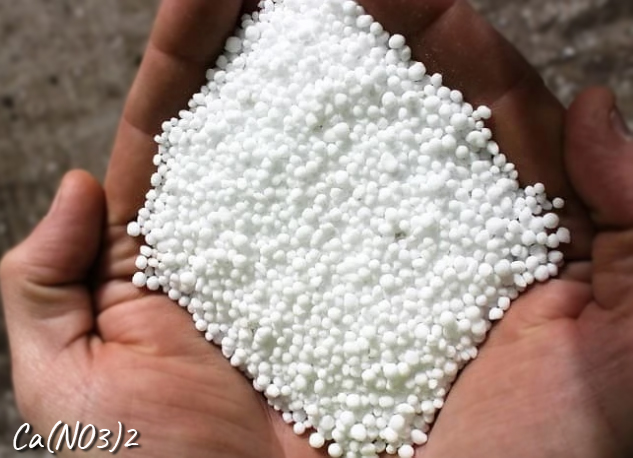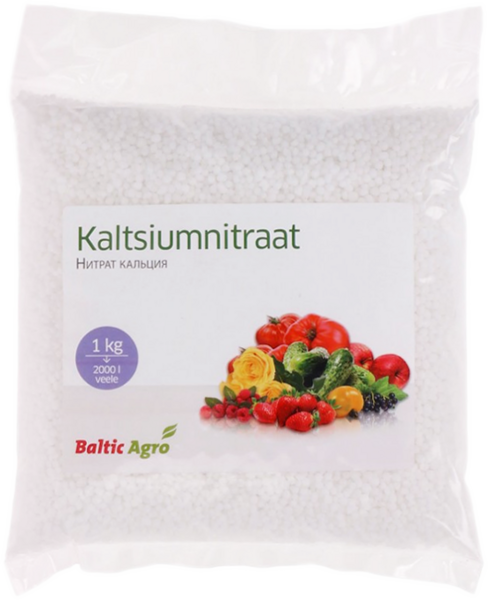The only physiologically alkaline fertilizer with a liming effect:
the unique combination of nitrate nitrogen and fully water-soluble calcium offers significant agrochemical benefits and properties not found in other fertilizers.
This makes calcium nitrate one of the most valuable mineral fertilizers, due to the dual effect of its introduction: nutrition and liming.
Calcium nitrate is necessary for use as a separate fertilizer to increase the calcium content in the soil, because in the soil it is in a form that is difficult to access for plants.
Top dressing with calcium nitrate (calcium in the composition is contained in the nitrate form) will allow plants to absorb calcium and get a high-quality harvest and increase the shelf life of fruits
(calcium provides the strength of cell walls and membranes).
They are introduced into the soil both in dry form and as a low-percentage solution for foliar, root dressing during the growing season.
Dosage. Dissolve the granules in water and water the plants with the prepared solution mixed with water-soluble fertilizer for tomatoes, cucumbers, flowers and berries.
Liquid top dressing: In the greenhouse: 10–20 g / 10 l of irrigation water.
Open ground: 10–20 g / 10 l of irrigation water. When fertilizing by spraying on the leaves: 2 tsp. tablespoons of 1% solution per 1 liter of water.
The fertilizer dissolves well in water and is easily absorbed by plants.

Ca(NO3)2.
Useful properties of calcium nitrate:
* increases the immunity of plants, resistance to temperature extremes, apical rot;
* stimulates the awakening of bulbs and seeds;
* accelerates photosynthesis, promoting the development of greenery and roots;
* Improves soil quality by absorbing metals and neutralizing acidity;
* Has a beneficial effect on the taste characteristics of the crop, prolongs the shelf life;
* Due to a calcium deficiency, plants absorb moisture and nutrients from the ground worse - when calcium nitrate is applied, the roots revive, and healthy vegetation is stimulated.
* provides full growth of the root part of the plant. Calcium nitrate is able to accelerate photosynthesis in the leaves, which leads to the strengthening of the plant walls.
Calcium contained in nitrate ensures complete assimilation of nitrogen;
* in soil fertilized with calcium nitrate, seeds germinate much faster, since enzymatic activity is activated;
* The roots grow strong and healthy, due to which they are practically not affected by bacteria and fungi.
* a solution of calcium nitrate increases the frost resistance of the plant (even at the lowest temperatures, crops do not freeze).
* Calcium nitrate solution is suitable for feeding most fruit trees.
* To get the predicted benefit, you should clarify what exactly calcium nitrate is used for. In most cases, it is planned to use it to increase the yield by 15%.
If the recommended dosage is followed, nitrates do not accumulate in the fruit.
Advantages and disadvantages of using calcium nitrate in agriculture.
Plants find it difficult to assimilate nitrogen from acidic soil (for example, ammonium nitrate and urea raise the pH).
Using calcium nitrate, it is possible to normalize acidity, which becomes noticeable already 2-3 weeks after application.
Beneficial bacteria are activated in the soil, thereby improving its structure and composition.
Calcium fertilizer neutralizes the harmful effects of metals and salts, preventing them from entering plant tissues.
The disadvantages of calcium nitrate are associated with incorrect timing of the treatment of the site and violation of the recommended dosage.
Due to an excess of calcium, tops and roots are destroyed, which cease to absorb nutrients and moisture from the soil, and an excess of liquid provokes rotting of plants.
To benefit from calcium nitrate, application rates must be calculated for each crop being cultivated. The dosage depends not only on the species, but also on the age of the plant.
Regardless of the amount of fertilizer, the soil must be well moistened before processing. This will save the root system from scalding.
Features of the application.
Feeding seedlings with calcium nitrate begins with the appearance of the third leaf. The treatment is repeated 10 days after the pick.
Carefully irrigate the soil at the root so as not to fall on the tops.
The working solution is prepared from the calculation: 10 g of calcium nitrate, 50 g of wood ash and 5 g of urea per 5 liters of water.
Considering that the underground part of cucumbers is characterized by slow development, it is necessary to carefully apply fertilizer.
As soon as 3 adult leaves appear, the seedlings can be sprayed with calcium nitrate. Top dressing under the root is carried out every 8 days until the stage of ovary formation.
The dosage is calculated based on the proportion of 2 g of the drug per 1 liter of water.
Peppers and tomatoes love this fertilizer. Thanks to foliar feeding, nightshades can be protected from black rot, mites and slugs.
A single treatment gives a long-term effect, up to the stage of crop maturation. Root feeding is allowed. A useful solution is prepared from 10 liters of water and 20 g of calcium nitrate.
The first watering is performed a week after planting the seedlings, then repeated weekly until flowers appear.
Calcium nitrate for white cabbage seedlings fits well, but for mature specimens it is extremely undesirable.
When planting, 1 tea is placed in the prepared hole. a spoonful of granules, lightly sprinkle with soil and plant seedlings.
Due to calcium nitrate, thin shoots will better resist pests and diseases, the leaves will not curl, and the growth dynamics will improve.
Strawberries in the garden are fed until the flowering stage, and raspberries and other berry bushes are fed until the buds open.
The working solution is prepared at the rate of: 30 g of calcium nitrate per 10 liters of water. Water the berry area abundantly.
Ornamental plants can and should also be fed so that their flowering is longer, and the quality and beauty of the buds are impeccable
(this is especially important for farms where flowers are grown for commercial purposes).
For eustoma and other flowers, calcium nitrate is chosen for effective protection against decay and as a stimulant for lush greenery.
Root feeding is carried out from the very beginning of the season, repeating the process after 10 days. If the buds begin to shrink,
it is recommended to alternate root treatment with spraying on the leaf. The nutrient solution is prepared at the rate of 2 g of calcium nitrate per 10 liters of water.
Combination.
In parallel with calcium nitrate, the use of urea and crushed ash is permissible. Organic fertilizers are not recommended for joint use, the same restriction applies to straw and sawdust.
Combinations of calcium nitrate with chalk, lime and growth stimulants, as well as with agrochemicals containing sulfur and phosphorus, are also banned.
If you use calcium nitrate correctly and dosed, the effect will only be positive.
P.S. Many field, vegetable, fruit, berry and flower crops are sensitive to soil acidity (low pH values).
These plants already experience discomfort at a pH slightly below 6.0, and at a pH below 5.0 their growth and development is inhibited or completely stopped, the plants become ugly and die.
In the process of natural circulation of substances, calcium is washed out from the soil, and human economic activity significantly enhances this process.
Soil decalcification occurs all over the world and is one of the global problems, as it leads to degradation and dehumification of the soil, increases its acidity and compaction,
destroys the structure, reduces water permeability and air exchange, and contributes to the development of erosion.
The consequence of these processes is a stable decrease in yield, deterioration of its quality, suppression of beneficial microbiological processes and the development of diseases.
The problem of decalcification negates the efforts of farmers to obtain a decent harvest on acidic soils.
Calcium nitrate, Norwegian saltpeter, Norgessalpeter. Ca(NO3)2.











